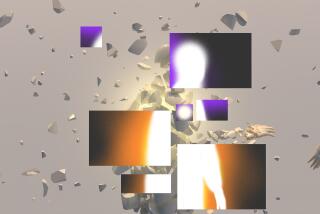Misreading the mind
- Share via
Since its inception in the early 20th century, neuroscience has taught us a tremendous amount about the brain.
Our sensations have been reduced to a set of specific circuits. The mind has been imaged as it thinks about itself, with every thought traced back to its cortical source. The most ineffable of emotions have been translated into the terms of chemistry, so that the feeling of love is just a little too much dopamine. Fear is an excited amygdala. Even our sense of consciousness is explained away with references to some obscure property of the frontal cortex. It turns out that there is nothing inherently mysterious about those 3 pounds of wrinkled flesh inside the skull. There is no ghost in the machine.
The success of modern neuroscience represents the triumph of a method: reductionism. The premise of reductionism is that the best way to solve a complex problem -- and the brain is the most complicated object in the known universe -- is to study its most basic parts. The mind, in other words, is just a particular trick of matter, reducible to the callous laws of physics.
But the reductionist method, although undeniably successful, has very real limitations. Not everything benefits from being broken down into tiny pieces. Look, for example, at a Beethoven symphony. If the music is reduced to wavelengths of vibrating air -- the simple sum of its physics -- we actually understand less about the music. The intangible beauty, the visceral emotion, the entire reason we listen in the first place -- all is lost when the sound is reduced into its most elemental details. In other words, reductionism can leave out a lot of reality.
The mind is like music. While neuroscience accurately describes our brain in terms of its material facts -- we are nothing but a loom of electricity and enzymes -- this isn’t how we experience the world. Our consciousness, at least when felt from the inside, feels like more than the sum of its cells. The truth of the matter is that we feel like the ghost, not like the machine.
If neuroscience is going to solve its grandest questions, such as the mystery of consciousness, it needs to adopt new methods that are able to construct complex representations of the mind that aren’t built from the bottom up. Sometimes, the whole is best understood in terms of the whole. William James, as usual, realized this first. The eight chapters that begin his 1890 textbook, “The Principles of Psychology,” describe the mind in the conventional third-person terms of the experimental psychologist. Everything changes, however, with Chapter 9. James starts this section, “The Stream of Thought,” with a warning: “We now begin our study of the mind from within.”
With that single sentence, James tried to shift the subject of psychology. He disavowed any scientific method that tried to dissect the mind into a set of elemental units, be it sensations or synapses. Modern science, however, didn’t follow James’ lead. In the years after his textbook was published, a “New Psychology” was born, and this rigorous science had no use for Jamesian vagueness. Measurement was now in vogue. Psychologists were busy trying to calculate all sorts of inane things, such as the time it takes for a single sensation to travel from your finger to your head. By quantifying our consciousness, they hoped to make the mind fit for science. Unfortunately, this meant that the mind was defined in very narrow terms. The study of experience was banished from the laboratory.
But it’s time to bring experience back. Neuroscience has effectively investigated the sound waves, but it has missed the music. Although reductionism has its uses -- it is, for instance, absolutely crucial for helping us develop new pharmaceutical treatments for mental illnesses -- its limitations are too significant to allow us to answer our biggest questions. As the novelist Richard Powers wrote, “If we knew the world only through synapses, how could we know the synapse?”
The question, of course, is how neuroscience can get beyond reductionism. Science rightfully adheres to a strict methodology, relying on experimental data and testability, but this method could benefit from an additional set of inputs. Artists, for instance, have studied the world of experience for centuries. They describe the mind from the inside, expressing our first-person perspective in prose, poetry and paint. Although a work of art obviously isn’t a substitute for a scientific experiment -- Proust isn’t going to invent Prozac -- the artist can help scientists better understand what, exactly, they are trying to reduce in the first place. Before you break something apart, it helps to know how it hangs together.
Virginia Woolf, for example, famously declared that the task of the novelist is to “examine for a moment an ordinary mind on an ordinary day ... [tracing] the pattern, however disconnected and incoherent in appearance, which each sight or incident scores upon the consciousness.”
In other words, she wanted to describe the mind from the inside, to distill the details of our psychological experience into prose. That’s why her novels have endured: because they feel true. And they feel true because they capture a layer of reality that reductionism cannot. As Noam Chomsky said, “It is quite possible -- overwhelmingly probable, one might guess -- that we will always learn more about human life and personality from novels than from scientific psychology.” In this sense, the arts are an incredibly rich data set, providing neuroscience with a glimpse behind its blind spots.
Some of the most exciting endeavors in neuroscience right now are trying to move beyond reductionism. The Blue Brain Project, for example, a collaboration between the École Polytechnique Fédérale in Lausanne, Switzerland, and IBM, is in the process of constructing a biologically accurate model of the brain that can be used to simulate experience on a supercomputer. Henry Markram, the leader of the project, recently told me that he’s convinced “reductionism peaked five years ago.” While Markram is quick to add that the reductionism program isn’t complete -- “There is still so much that we don’t know about the brain,” he says -- he’s trying to solve a harder problem, which is figuring out how all these cellular details connect together. “The Blue Brain Project” he says, “is about showing people the whole.” In other words, Markram wants to hear the music.
One day, we’ll look back at the history of neuroscience and realize that reductionism was just the first phase. Each year, tens of thousands of neuroscience papers are published in scientific journals. The field is introduced to countless new acronyms, pathways and proteins. At a certain point, however, all of this detail starts to have diminishing returns. After all, the real paradox of the brain is why it feels like more than the sum of its parts. How does our pale gray matter become the Technicolor cinema of consciousness? What transforms the water of the brain into the wine of the mind? Where does the self come from?
Reductionism can’t answer these questions. According to the facts of neuroscience, your head contains 100 billion electrical cells, but not one of them is you, or knows you or cares about you. In fact, you don’t even exist. You are simply an elaborate cognitive illusion, an “epiphenomenon” of the cortex. Our mystery is denied.
Obviously, this scientific solution isn’t very satisfying. It confines neuroscience to an immaculate abstraction, unable to reduce the only reality we will ever know. Unless our science moves beyond reductionism and grapples instead with the messiness of subjective experience -- what James called a “science of the soul” -- its facts will grow increasingly remote. The wonder of the brain is that it can be described in so many ways: We are such stuff as dreams are made on, but we are also just stuff. What we need is a science that can encompass both sides of our being.
Jonah Lehrer, an editor at large for Seed magazine, is the author of “Proust Was a Neuroscientist.”
More to Read
A cure for the common opinion
Get thought-provoking perspectives with our weekly newsletter.
You may occasionally receive promotional content from the Los Angeles Times.










